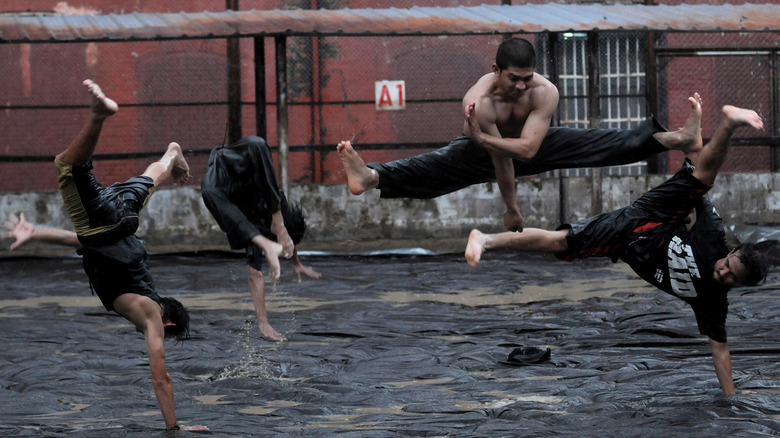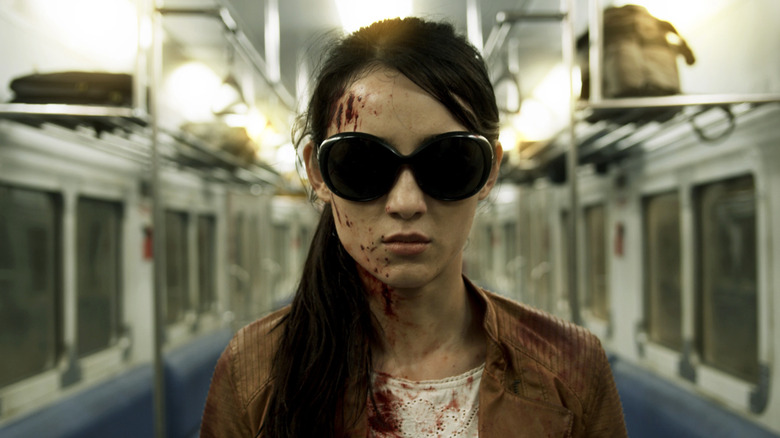How Gareth Evans Kept The Raid From Being Too Over The Top
Hyperbolic language is all the rage these days, with every movie being described as either the "best/worst thing ever," but I can say with no exaggeration — "The Raid" is the coolest f***ing movie of all time. Don't @ me. Don't fight me. Just accept that this is a correct statement and take a deep breath. Director Gareth Evans revitalized the way we approach action films with his 2011 film starring Iko Uwais, and unfortunately for literally every action film with cool fight scenes that has come out in its wake, they've all unfairly had to live in its shadow. In fact, it wasn't until "The Raid 2: Berandal" came out in 2014 that another action film could hold a candle to the previous film's accomplishments, and somehow went even harder.
"The Raid" (aka "The Raid: Redemption") features Uwais as a rookie member of an elite command force named Rama, who is sent out on a mission to take down a ruthless crime lord named Tama (Ray Sahetapy) who runs business out of a high-rise apartment block. After the group's cover is blown, Tama announces that he will offer free sanctuary to anyone in the apartment block who can take down the command force. Now, Rama and his comrades are forced to fight nearly every resident in the building, working their way to the penthouse to take down Tama once and for all. If this sounds like the mission of a video game leading to a final boss, you're damn right it does, and it's awesome. "The Raid" is non-stop high octane ass-kicking, but despite the film being like, 70% fight scenes, Evans successfully keeps the film from becoming a campy mess, and instead plants it firmly on the side of "HELL YEAH!"
The camera never lingers on the violence
For a movie that features such an overwhelming amount of fight sequences, Gareth Evans was meticulous in how the fight scenes were shot, and how the film was edited. During a 2017 interview, he confirmed that this decision was intentional. "There's a subtle difference about how long a camera lingers on violence, and how much detail is shown," he said. "Almost all the extreme violence in 'The Raid 2' either cuts away on impact, moves onto another opponent, or happens at a distance in a wide shot."
Evans is correct, while both of "The Raid" films are loaded with violence, it never feels exploitative or mean-spirited. The fighting is a necessary means of survival, but the motivations of the characters participating in the violence are given equal importance.
There are moments in "The Raid 2" where I wanted to use the camera to question screen violence. When we hold on the shotgun blast — you have a wide frame to look at, you choose where your gaze falls. But violence is pointless if you don't also use it to say something about the characters. The restaurant scene in "The Raid 2," with the lineup of men having their throats slit, barely shows any actual detail of violence. The focus of the scene is about the psychology of [crime boss villain] Bejo and [antihero] Uco, who are capable of committing and witnessing such brutality, yet still conducting a business meeting at the same time.
Evans also mentioned a moment when Rama burns a corrupt officer on a hot plate, and that what is shown is merely the aftermath. The camera instead focuses on Rama, who is struggling to navigate his new reality surrounded by violence. "It's how you present violence that is the key component of this differentiation," said Evans. "If it has something to say about your characters, then it can be as important as a scene of dialogue."
Rama vs. The Assassin
While all of the fight scenes in the two "Raid" movies are pure cinematic gold, perhaps the best example of this grounded violence takes place in "The Raid 2" when Rama, after having just fought off Hammer Girl (Julie Estelle) and Baseball Bat Man (Very Tri Yulisma) comes face to face with The Assassin (Cecep Arif Rahman) in a kitchen fight to the death. It's very clear that The Assassin never imagined Rama would get this far, and rather than immediately attack one another, there's a sign of mutual respect as they line up to spar, getting a feel for each other's abilities and weaknesses.
It's a powerful moment devoid of any dialogue, as their physical interactions truly tell the story of what is at play. It's a scene that also, quite frankly, kicks a metric ton of ass and deserves to be enjoyed by all.

